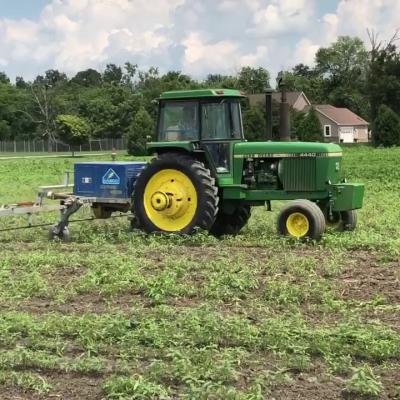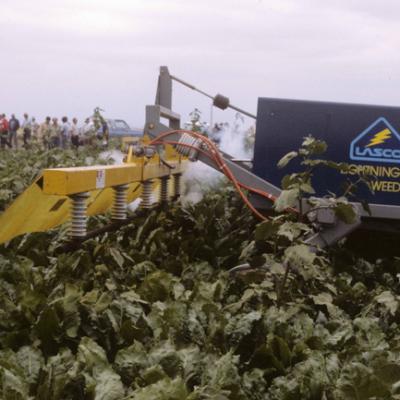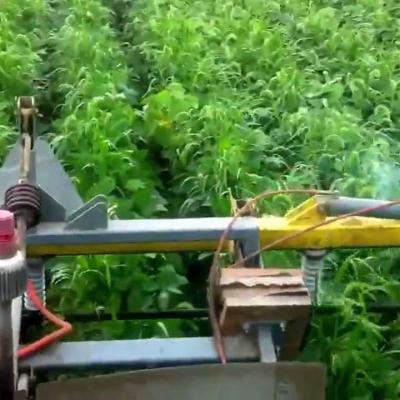LASCO LIGHTNING WEEDER
General Theory of Operation
The key to expert weed control is to know the fundamentals of the LASCO ELECTRIC DISCHARGE SYSTEM (EDS) LIGHTNING WEEDER operation. When you know how your machine operates, you can make the necessary adjustments and changes in operation to achieve maximum weed control.
There are five major areas that should be discussed in the general theory of operation and they are: (1) basic principles of electricity, (2) how the machine kills weeds, (3) an overview of operation, (4) safety, and (5) the availability of standby power.
Electricity cannot be seen, but is a very useful tool in a number of applications. In order to "see" electricity, it may be compared to water. Simply stated, electricity is made up of extremely tiny electrons which flow through a conductor much like water flows through a pipe. When speaking in terms of flow, three parameters are usually discussed, and they are: (1) flowrate, (2) pressure or potential, and (3) pressure loss due to friction. In electricity, flowrate is measured in amperes, pressure is measured in volts, and pressure loss (resistance to flow) is measured in ohms. In order for electricity to flow, a "pump" (voltage source) and a "pipe" (conductor) must be provided. The EDS LIGHTNING WEEDER produces a high voltage electrical current and forces weeds to conduct this current which will evaporate liquid material in the weed, cause cell walls to rupture, and effectively destroy life in the plant.
There are several factors which affect weed control with the EDS LIGHTNING WEEDER. The amount of contact between the applicator bar and the weeds will affect the level of weed control. Also, the level of control depends upon the specie and its conductivity. The machine is most efficient when contact is made between the applicator bar and the main stem and as many branches as possible. A single-stemmed weed, therefore, is usually easier to control than a many-branched weed. Younger weeds are generally easier to kill than more mature weeds. Scattered weeds are easier to kill than dense weed populations; so, it is advisable to treat each field more than one time during each season (three times is typical) as weeds are easier to treat when they are young and scattered than when they are mature and densely populated. A general guideline to determine when an operation is needed is when the weeds are 4" to 6" taller than the crop plants.
THE EDS LIGHTNING WEEDER applicator is hydraulically controlled for height adjustment and its electrical output is controlled from an operator control panel. For optimum results, the applicator bar height should be adjusted to pass just over the top of the crop plants. If the bar is too low, the crop plants themselves will become conductors and either growth will be stunted or the plant will be destroyed. On a sugar beet plant, for example, individual leaves will be destroyed on contact and if enough leaves are destroyed, yield reduction will occur. Excessive crop clearance, however, will result in missing many weed plants that are only slightly higher than the crop plants; so the operator must operate the EDS LIGHTNING WEEDER at optimum clearance.
The machine's electrical output is controlled from a control panel which should be mounted within easy reach and view of the operator for safety and ease of operation.
When operating the EDS LIGHTNING WEEDER, think SAFETY! Dangerous and potentially lethal electrical shock can result from misuse of this machine! Study the manual carefully before attempting to assemble, operate, or repair the machine. The power source for the machine is a PTO driven, brushless alternator that produces a voltage which is transformed into a high working voltage and is connected to the applicator bar through high voltage cables. It is essential that this high voltage cable be protected from abuse and its end connections and insulation should not be tampered with or altered in any way! The applicator bar is shielded to help prevent accidental contact with persons, pets, or livestock. DO NOT REMOVE THESE SHIELDS AND DO NOT OPERATE AN EDS MACHINE WITHOUT THESE SHIELDS BEING SECURELY IN PLACE.
It must never be assumed that shields will adequately protect any person or animal from lethal shock. The shields are an added precaution and must not be taken as an implication that they are safe to touch. Except for the control panel, all parts of the EDS LIGHTNING WEEDER including the applicator bar, wings, shields, coulters, and generator housings should be considered dangerous and potentially lethal to touch any time the tractor engine is running.
The EDS LIGHTNING WEEDER has a safety interlock system for safety purposes that will break the circuit of the generator power output when any one or more of the following conditions occur:
1) Operator not sitting in the operator's seat on the tractor.
2) Forward speed of the tractor is not at least approximately 1 MPH (2 to 6 MPH is the recommended forward speed range).
3) Coulters are lifted out of the ground.
4) Overheating of either the transformer or the generator (which may occur from excessive load current for long durations).
5) If any of the safety interlocks fail in the ON position, the machine should be considered unsafe and you should contact your dealer immediately.
These features reduce the danger to the operator or bystander and also reduce the possibility of damage to the equipment.
The EDS LIGHTNING WEEDER also has the capability to be used as a standby power source with up to 60 KW of auxiliary power. The machine is especially convenient during power outages or when a power source is needed for in-field service.
Read the manual carefully and understand the principles of operation that make the EDS LIGHTNING WEEDER work. Only when the machine is properly used can it be the effective tool for which it was designed. IT IS YOUR RESPONSIBILTY TO READ AND THOROUGHLY UNDERSTAND THE INSTRUCTIONS. IT MAY SAVE YOUR LIFE!




